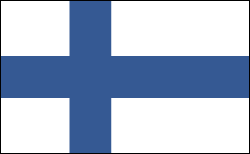Finland
 Republic of Finland Republic of FinlandNational name: Suomen Tasavalta—Republiken Finland President: Tarja Halonen (2000) Prime Minister: Matti Vanhanen (2003) Land area: 117,942 sq mi (305,470 sq km); total area: 130,558 sq mi (338,145 sq km) Population (2007 est.): 5,238,460 (growth rate: 0.1%); birth rate: 10.4/1000; infant mortality rate: 3.5/1000; life expectancy: 78.5; density per sq mi: 44 Capital and largest city (2003 est.): Helsinki, 1,162,900 (metro. area), 582,600 (city proper) Other large cities: Espoo, 229,500; Tampere, 201,200; Vantaa, 189,200; Turku, 178,100 Monetary unit: Euro (formerly markka) Languages: Finnish 92%, Swedish 6% (both official); small Sami- (Lapp) and Russian-speaking minorities Ethnicity/race: Finn 93.4%, Swede 5.7%, Sami (Lapp) 0.1%, Roma 0.2%, Estonian 0.2% Religions: Evangelical Lutheran 84%, Greek Orthodox 1%, other Christian 1%, none 14% Literacy rate: 100% (2000 est.) Economic summary: GDP/PPP (2006 est.): $176.4 billion; per capita $33,700. Real growth rate: 5.5%. Inflation: 1.7%. Unemployment: 7.0%. Arable land: 7%. Agriculture: barley, wheat, sugar beets, potatoes; dairy cattle; fish. Labor force: 2.62 million; agriculture and forestry 8%, industry 22%, construction 6%, commerce 14%, finance, insurance, and business services 10%, transport and communications 8%, public services 32%. Industries: metals and metal products, electronics, machinery and scientific instruments, shipbuilding, pulp and paper, foodstuffs, chemicals, textiles, clothing. Natural resources: timber, iron ore, copper, lead, zinc, chromite, nickel, gold, silver, limestone. Exports: $84.72 billion f.o.b. (2006 est.): machinery and equipment, chemicals, metals; timber, paper, pulp (1999). Imports: $71.69 billion f.o.b. (2006 est.): foodstuffs, petroleum and petroleum products, chemicals, transport equipment, iron and steel, machinery, textile yarn and fabrics, grains. Major trading partners: Sweden, Germany, Russia, UK, U.S., Netherlands, Denmark, France (2004) . Communications: Telephones: main lines in use: 2.12 million (2005); mobile cellular: 5.231 million (2005). Radio broadcast stations: AM 2, FM 186, shortwave 1 (1998). Television broadcast stations: 120 (plus 431 repeaters) (1999). Internet hosts: 1.634 million (2006). Internet users: 3.286 million (2005). Transportation: Railways: total: 5,741 km (2005). Highways: total: 78,189 km; paved: 50,633 km (including 653 km of expressways); unpaved: 27,556 km (2006). Waterways: 7,842 km note: includes Saimaa Canal system of 3,577 km; southern part leased from Russia (2004). Ports and harbors: Hamina, Hanko, Helsinki, Kotka, Naantali, Pori, Porvou, Raahe, Rauma, Turku. Airports: 148 (2006 est.). International disputes: various groups in Finland advocate restoration of Karelia and other areas ceded to the Soviet Union, but the Finnish Government asserts no territorial demands. |
Geography
Finland is three times the size of Ohio. It is heavily forested and contains thousands of lakes, numerous rivers, and extensive areas of marshland. Except for a small highland region in the extreme northwest, the country is a lowland less than 600 ft (180 m) above sea level. Off the southwest coast are the Swedish-populated Åland Islands (581 sq mi; 1,505 sq km), which have had an autonomous status since 1921.
Government
Republic.
History
The first inhabitants of Finland were the Sami (Lapp) people. When Finnish speakers migrated to Finland in the first millennium B.C., the Sami were forced to move northward to the arctic regions, with which they are traditionally associated. The Finns' repeated raids on the Scandinavian coast impelled Eric IX, the Swedish king, to conquer the country in 1157. It was made a part of the Swedish kingdom and converted to Christianity.
By 1809 the whole of Finland was conquered by Alexander I of Russia, who set up Finland as a grand duchy. The period of Russification (1809–1914) sapped Finnish political power and made Russian the country's official language. When Russia became engulfed by the March Revolution of 1917, Finland seized the opportunity to declare independence on Dec. 6, 1917.
The USSR attacked Finland on Nov. 30, 1939, after Finland refused to give in to Soviet territorial demands. The Finns staged a strong defense for three months before being forced to cede the Soviets 16,000 sq mi (41,440 sq km). Under German pressure, the Finns joined the Nazis against Russia in 1941, but they were defeated again and forced to cede the Petsamo area to the USSR. In 1948, a treaty of friendship and mutual assistance was signed by the two nations. Finland continued to pursue a foreign policy of nonalignment throughout the cold-war era.
Running on a platform to revitalize the economy, Ahtisaari, a Social Democrat, won the country's first direct presidential election in a runoff in Feb. 1994. Previously, presidents had been chosen by electors. Finland became a member of the European Union in Jan. 1995. On Jan. 1, 1999, Finland, along with ten other European countries, adopted the euro as its currency. In 2000, Tarja Halonen, who had been Finland's foreign minister, became its first woman president.
Since 1998, Finland has been judged to be the world's least corrupt country, according to the annual survey by the Berlin-based organization Transparency International. In April 2003, Finland appointed its first female prime minister, making it the only country in Europe with both a female president and prime minister. But Prime Minister Jaatteenmaki resigned after only two months in office when it was revealed that she had used leaked classified information against her rival in the election (she was acquitted of the charges the following year). In June, Defense Minister Matti Vanhanen was selected by parliament to replace her. In Jan. 2006, President Halonen was reelected. Vanhanen's Centre Party narrowly won parliamentary elections in March 2007, and he was reelected to a second term.
Hiç yorum yok:
Yorum Gönder